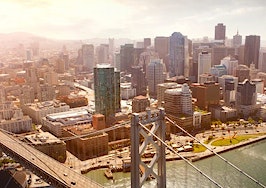- San Francisco's public transit system hasn't been updated in 35 years to accommodate the growth of the city.
- Building upwards is controversial, but it could help ease the growing pains of population increases.
- The future of San Francisco and its affordability could hinge on the lack of housing.
Missed part one? Catch up here.
With increased San Francisco housing density, the city must also improve its antiquated public transportation system. The BART system in the city has not been updated in 35 years and it shows.
The infrastructure feels worn, and the trains show their tear.
The system is not nearly large enough to keep up with the growth of the city through the decades, and shifting to other systems such as public buses and light rail is not exactly seamless.
Recently I made a trip to Beijing and Shanghai, two mega-cities with populations larger than New York and higher population densities. Both cities had gleaming and extensive subway systems, which rank as the largest in the world. It was extremely easy to get around various and distant corners of each metropolitan area without even having to be above ground.
These cities are linked to other nearby suburbs and sizable metropolitan areas with high speed rail links, which have dramatically cut traditional transport times. It felt like a great luxury to be able to use such efficient transportation systems, and I do not see why we can’t experience that here, especially with needs so crucial.
Plans are already in the works for improving and expanding the city’s subway system.
The Central Subway light rail project plans to link the heavily trafficked corridor from Mission Bay to Union Square and to Chinatown. This represents the biggest investment in public transport that the city has made in years.
Currently in Phase II, the project is due to be operational by 2019.
Currently, San Francisco transit planners are examining further plans to extend and improve the city’s subway system and to cope with the increased population density brought on by the new construction and development projects throughout San Francisco’s Mission Bay to Mid-Market areas.
Preparing for the San Francisco of the future
San Francisco is currently undergoing a period of profound economic and social change. These transitions rarely go without hiccups, and increasing hostility in the city toward wealthy young techies and gentrification of established neighborhoods are part of the symptoms of this underlying tension.
The city as a whole needs to work together to come up with and embrace positive solutions for San Francisco to step forward into the future.
Preventing new construction and development is no longer a luxury we can afford. In order for the city to both prosper, accommodate new populations without exacerbating issues of housing affordability, the city has no choice but to dramatically increase housing density.
This Manhattanization of San Francisco must go hand in hand with a comprehensive and long term investment in the modernization, expansion and improvement of the scope, scale and efficiency of our public transportation system.
Being the Manhattan of the West Coast is no longer a distant dream for some– it is an absolute necessity for San Francisco’s future prosperity and socio-economic balance.
As realtors, we have a responsibility to work toward the betterment of the communities we serve. Thankfully, San Francisco has never been a hard city to sell.
However, in order to make sure that it can remain a place where normal working families can live and work, the number of housing units available in the city need to keep pace with rapidly rising demand.
We can get involved by providing our own unique insight as real estate professionals in the public arena and the education of the local populace regarding pressing housing issues. At the same time, we should also work with local citizens who are concerned about the pitfalls of increasing developments and make sure that their concerns and fears are taken into account.
By sharing valuable expertise, realtors can make a difference in crafting a viable, comprehensive and less polarized vision of how San Francisco can walk confidently into the future by both embracing change and growth.
Frederick Kuo is a San Francisco based real estate broker, consultant and published blogger. He is a graduate of UCLA and his writing is focused on current events, real estate trends and history. He covers projects throughout Northern California and can be reached at frederickkuo.com.








